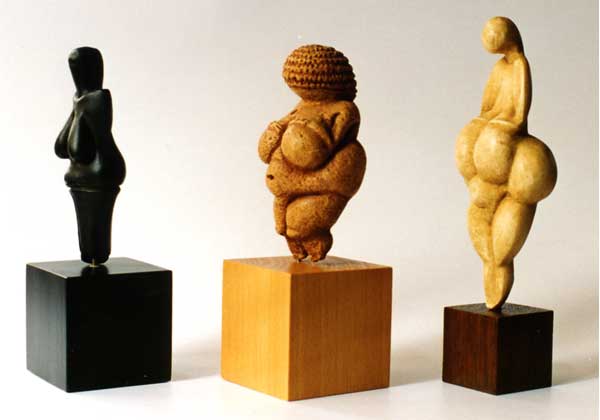Since the early stages of human life and prosperity, art has used by different societies to display their craftsmanship and to demonstrate their beliefs. Two types of artistic creations are the paleolithic Venus figurines from southern France and the bronze age jade figurines of China. These two art pieces contrast in both usage and symbolism. The figurines in the paleolithic, European era were made by hunters and gatherers, while jade figurines during the Bronze Age are part of an advanced civilization. Still, both provide scholars insight into the practices and goals of the people at the time.

One of the earliest forms of art includes the figurines from the European paleolithic era. Created by homo sapiens about thirty thousand years ago, they were called Venus figurines by scholars after the Roman goddess of love Venus, because they depict the body of a woman. Today, more than one hundred have been found and they all have similar characteristics. The figurines range in height but are on average 150mm tall. They are made from materials such as steatite, calcite, limestone, bone, ivory, and clay.1
Today we wonder about the meaning and purpose behind the faintness of facial features and hands in these figurines, yet we note the emphasis on the woman’s hips and legs. Although we do not yet have definite answers to this question, there are many theories available. One popular theory is that the societies that created these figurines had a deep interest in female fertility. Other theories mention their hope for survival and fear for extinction.2 A less popular and more controversial theory is the possibility that Venus figurines were self portraits.3 Still, different theories are necessary in order to better comprehend the motifs behind the Venus figurines and their crafters.

In contrast to the Venus figurines in Europe, Chinese jade figurines offer a clearer sense of the usage of art in the Bronze Age. Jade figurines were often buried with wealthy individuals along with their former slaves, food, jewels, and many other objects. Although the jade figurines took very long to make and were a process of hard labor, their symbolism of prosperity and luxury in Chinese ceremonial traditions demonstrate the practice of ancestral worship and how important it was to them. Because they believed spirits passed into another realm of existence, from which they had the power to affect future generations, tombs were lavished with tools so that masters might live plentifully along with sacrificed slave bodies that would continue to serve their master. For example, in the tomb of lady Fu Hao, wife of the Shang king Wu Ding, 755 jade carvings, 468 bronze objects, 130 weapons, and 4 mirrors were buried.4
Although prehistoric pieces such as figurines, cave paintings, and carvings are often overlooked because of the ambiguity of their meaning, they convey people’s emotions, ideas, and talents. Creations such as the Venus and jade figurines provide the world insight into the practices of our ancestors and the kinds of resource available to them. They serve as a timeline and teach us about their interests and abilities in eras as diverse as the European Paleolithic and Chinese Bronze Ages.
- Kaylea Vandewettering, “Upper Paleolithic Venus Figurines and Interpretations of Prehistoric Gender Representations,” PURE Insights 4, no. 1 (May 29, 2015), http://digitalcommons.wou.edu/pure/vol4/iss1/7. ↵
- Jerry H. Bentley, Herbert F. Ziegler, Traditions and Encounters: A Global Perspective on the Past Volume 1: From the Beginning to 1500 (New York, NY: McGraw-Hill, 2011), 14. ↵
- Kaylea Vandewettering, “Upper Paleolithic Venus Figurines and Interpretations of Prehistoric Gender Representations,” PURE Insights 4, no. 1 (May 29, 2015), http://digitalcommons.wou.edu/pure/vol4/iss1/7. ↵
- Jerry H. Bentley, Herbert F. Ziegler, Traditions and Encounters: A Global Perspective on the Past Volume 1: From the Beginning to 1500 (New York, NY: McGraw-Hill, 2011), 92-93. ↵



61 comments
Ava Rodriguez
This was an interesting article about figurines. I have never heard of the two different types of figurines before. It is cool how important they are but their meanings have not been found. The skills from this time period is very impressive. The figurines were also used in burials which is also interesting because every culture seems to have a similar burial by burying people with items.
Vanessa Sanchez
Never have I ever heard about this figures. It is pretty amazing learning about new things specially as interested as these. Its crazy that even up to this day there isn’t really meaning for the figures. It in fact has a huge impact in history showing from where art was starting and how it still goes around in a much more renovated way but practices are still around even after decades.
Tyler Reynolds
I know that figurines of idols are important to some religions and their practices but one could also argue that they had different functions. The figurines could be used to show status or devoutness to the local deity, tribe, or people of a place. In addition, certain figurines had very…..pronounced sexual features. In addition, there have been bronze medallions/pendants shaped like sexual organs found in Rome’s archeological sites. What these were used for is anyone’s guess.
Thomas Fraire
It was so intriguing to think about those two distinct sorts of dolls that I’ve never heard. Every puppet has every one of a kind highlights and history, which made me so pulled in. I suspected that the Chinese custom around then that they covered renowned individuals with a few things, gems and image of extravagance like the jade dolls is resemblant to that of old Egypt.
Diego Terrazas
I believe the Venus figurines were symbolic of female fertility, perhaps even ancestors who were worshiped for their high fertility rates. Furthermore, I highly doubt they were portraits but more of generic images of women. Nonetheless, it is fascinating to see how we created art at such an early time, and how that interest still persists, but in much greater quality and quantity.
Lilliana Canales
It’s interesting that all of these figurines beard similar features, it also poses a question as to who these figurines represented. In an era where food as not in a sufficient amount, why were these figurines so plump? The figurines will always be a mystery and only answered by theory, but at the least, they offer us with the fact that paleolithic persons along with those in the ancient world were capable of creating art whether they realized it or not.
Eric Ortega Rodriguez
History can be found in numerous places and these figurines are an history in a way I would have never thought of. This article was fascinating in the sense that civilizations used these figurines as a way to express themselves and express what they believed was beautiful. Though the real meaning behind them is not certain, I would assume they represent the beauty of fertility since it is something that is seen as beautiful in art through multiple eras. Overall, this was a very creative and original topic selection. Good work.
Kaitlyn Killebrew
When I read the title I had assumed that it would have been about comparing Venus figures used by the ancient world from country to country, though it was not what I expected I was still able to learn from it. I knew that in most cultures that the Venus figure usually correlates with that of fertility and their god/goddess of fertility but it was nice reading about it in their aspect of material used in making of the figurines.
Valeria Perez
Though the art made by the ancient people in different parts of the world look very different from contemporary art, I am always impressed by the amount of skill and talent these early artists had. They made these intricate figurines out of materials which do not allow any mistakes! How long must have people practiced in order to get to their expertise level? This was a great article!
Honoka Sasahara
It was so interesting to know about those two different types of figurines that I’ve never heard before. Each figurines have each unique features and history, which made me so attracted. I thought that the Chinese custom at that time that they buried famous people with some items, jewelries and symbol of luxury like the jade figurines is resemblant to that of ancient Egypt.